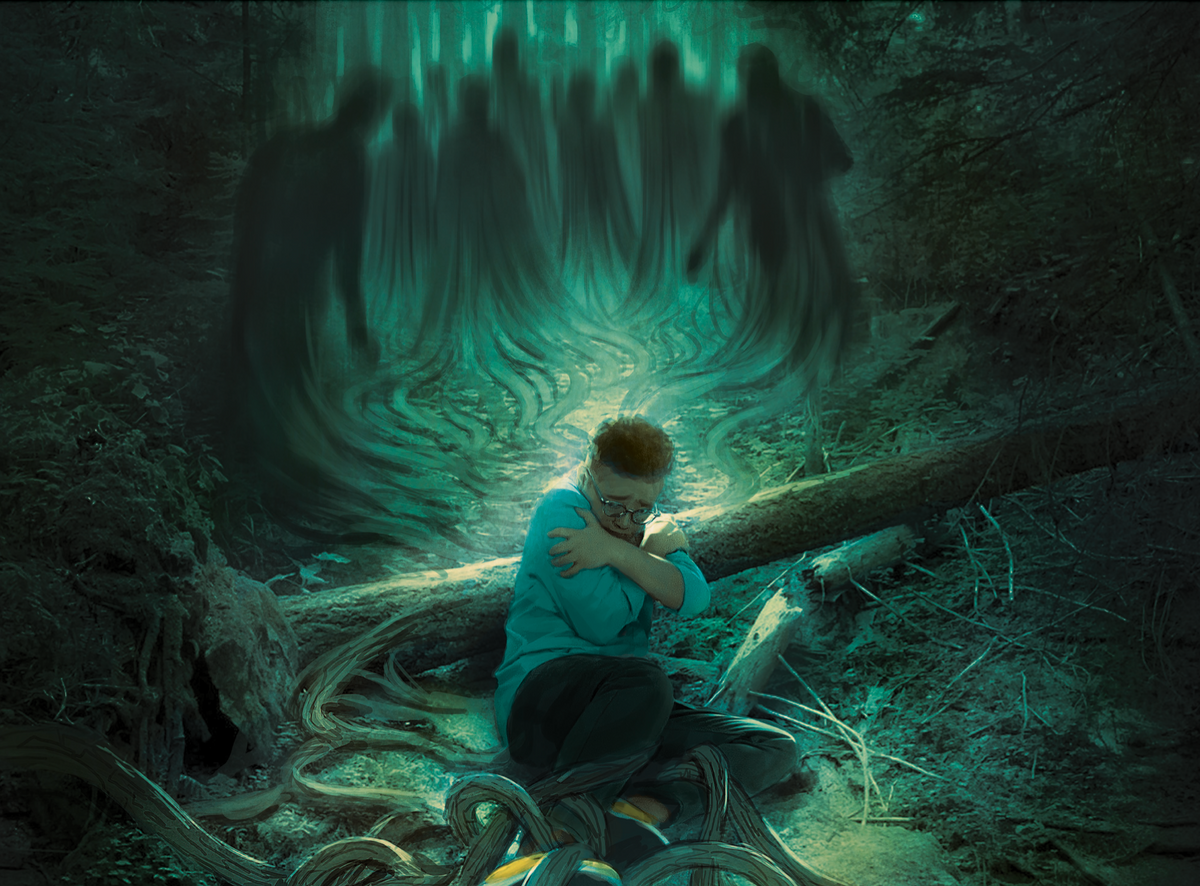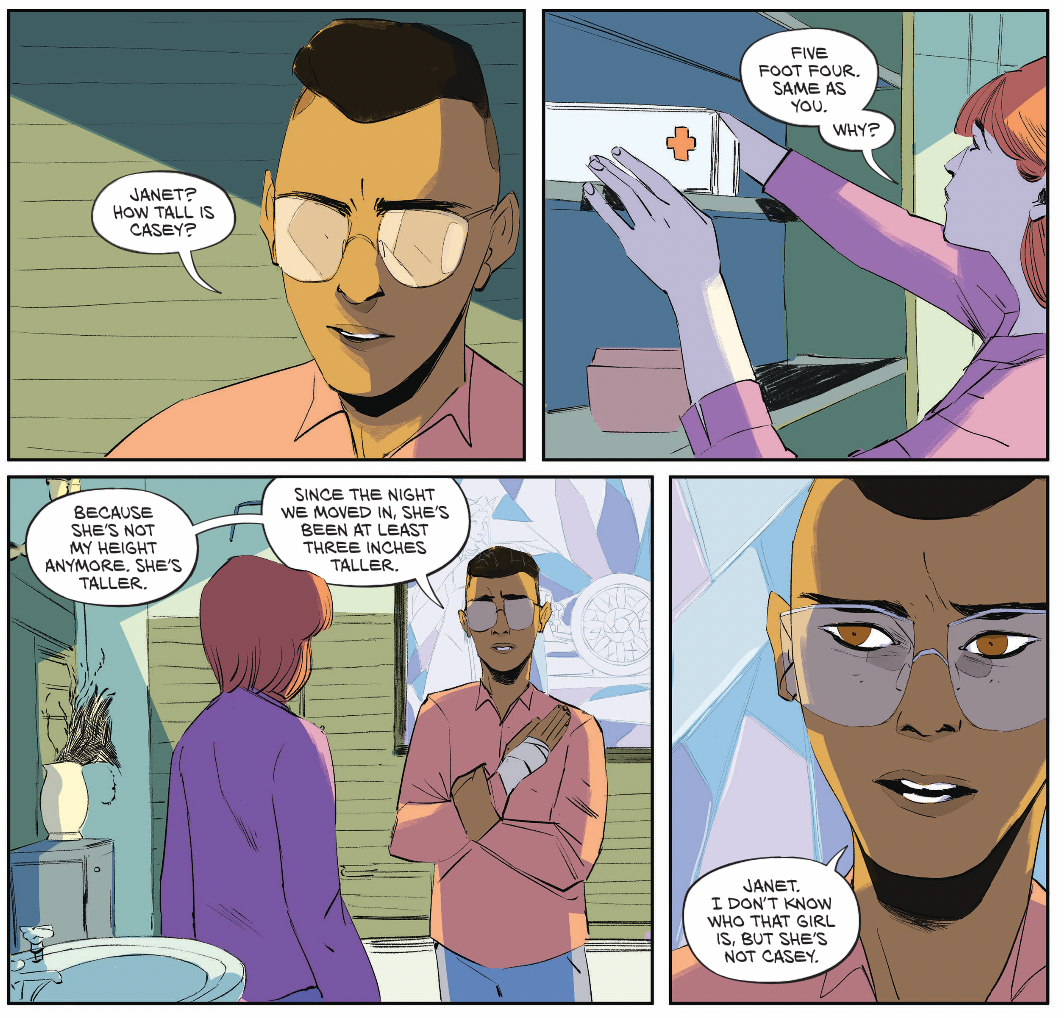Surrounded: The Neighbors #3

The third installment of The Neighbors – my comic, blessed by the extremely creepy art of Miguel Mercado (on covers) and Letizia Cadonici (everywhere else) – goes on sale today. We're right in the middle of the story now, and things are picking up. Go grab an issue at your local comic shop, or buy an e-reader version on Comixology and Google Play, and then read the essay below. As always: If you like it, tell a friend. It helps a lot more than you'd think.
The guy who used to live in my house keeps “just swinging by” to pick up the things he left in the basement. I don’t know how to say no to him, but if I don’t figure out how eventually, I think he might move back in.
Small towns are not safe places. This is particularly true if you are visibly queer, or a person of color, but anyone with social deficits or noticeable oddities is at risk. People talk to each other. They’ve known each other for decades or generations. In the city, you have a bad interaction, you just have one bad interaction. You might never see the other person again.
Out here, consequences linger. They extend beyond one argument or incident or refusal to let a man take a bird bath out of a lawn that stopped being his over six months ago, a bird bath you honestly thought came with the building. Blow one relationship, and you potentially blow your relationship with everyone that person knows, which (since there aren’t that many people here) might be most of the people you encounter every day.
You can go from being completely welcome to being completely unwelcome very quickly in small communities. People from small towns are “nicer” than people from cities, but it’s not because they want to be. It’s because they know they’re being watched.
The Neighbors is a work of small-town horror; it derives from the paranoia of a social context where everybody knows everybody and nobody knows you. This paranoia is something I felt acutely after coming out. Middle-class white trans men are very far from being the main victims of transphobic violence, but that didn’t stop me from seeing hate crimes in every side-eye. Every time I walked through a parking lot I wondered if someone would run me over.
That fear has faded. I’ve walked through a lot of parking lots without getting hurt. Oliver’s fear of the outside world, in The Neighbors, is not mine — it’s exaggerated, overwhelming, destructive to him and to the people who love him — but it’s a fear I can understand, just as I can find parts of myself in Casey’s childish malice or Janet’s frustration at being shunted into the role of “caregiver” even when it means ignoring everything else about who she is. There is a lot of room for terrified people in a genre about terror, and Oliver, in some senses, is a classic horror archetype: The person who sees more because he fears more, who seems crazy because the truth is crazy, the one who insists that you have to believe me, please, it’s… trying… to… kill me!!!!
That person is almost always a woman, usually (in haunted house stories) a wife, which seems like a reflection of what our culture thinks a “hysterical,” “overreacting,” less-than-credible person looks like. (Of course, it always turns out that this person was correct, and that it was a mistake not to listen to them, which is one of the routine feminist triumphs of the genre.) This time, I thought it should be Oliver. It felt important to get inside Oliver’s hypervigilance, his belief that the world is out to get him, precisely because it is not unreasonable. His paranoia is not “crazy,” it is (like most “crazy” behavior) a necessary survival strategy that has spiraled out of control.
Oliver has been targeted for hatred and violence, on multiple fronts, for his entire life. Oliver has always needed to examine the world, and other people’s motivations, a little bit more carefully than most people. His safety has always relied on his ability to imagine the worst-case scenario or guess the ugliest possible thing someone might be thinking. Now, he’s in a scenario that is more worst-case than most. He could be paranoid, or he could be the only one reacting appropriately to the situation.
The world really is out to get some people. Those people typically find ways to cope with it, or to stop thinking about it, because if they didn’t, they wouldn’t be able to leave the house. Some people stop leaving the house — which is no guarantee of safety. The world is always out there, trying to get back in.
Inspiration
This month, a selection of creepy small towns and horrible neighbors to increase your daily paranoia.
Rear Window (Alfred Hitchcock, 1954)
Paranoia works well in cities, too, where you are surrounded by people who are part of your daily routine while also being total strangers. This movie — universally known, endlessly ripped off — was the first and most direct inspiration for Oliver’s situation, specifically the sheer amount of time he spends staring out the window at the neighbor lady.
The Stepford Wives (Bryan Forbes, 1974)
This has a reputation for being campy, but a lot of it is funny on purpose. (The movie’s best scene has the wife-bots talking to each other in lines out of a dishwashing liquid commercial because the men who programmed them literally don’t know how women talk to each other when men aren’t around.) The premise of outsiders being forcibly absorbed into a placid suburban setting is still extremely creepy, as our next entry shows.
Get Out (Jordan Peele, 2017) & Us (Jordan Peele, 2019)
Peele’s first movie is a direct inheritor of The Stepford Wives, but his second picture is similarly obsessed with identity and the borders of self — are “you” your body? Your experiences? How much “you” can you lose, and still remain yourself? — and Lupita Nyong’o’s final scene still gives me chills.
Speak No Evil (Christian Tafdrup, 2022)
A lot of people boil Peele’s first two movies down to their social messages, but treating the films like TED Talks on race and racism doesn’t do nearly enough to honor them as horror. That’s why Speak No Evil — a Scandinavian exercise in mounting social unease, which owes an obvious debt to Peele in terms of set-up, atmosphere and even specific images, yet takes them in a completely different direction — is so refreshing. By “refreshing,” I mean that it’s the single most disturbing thing I’ve ever seen.
Rosemary’s Baby (Roman Polanski, 1968)
Don’t move next door to witches! It never works out!
“In the Hills, the Cities,” by Clive Barker
This short story, along with the one listed below, has done more than anything else to convince me that I really don’t want to know what the hell people get up to in their charming rural villages. There is strength in community, sometimes very literally, and if anyone invites you to partake in a time-honored local tradition, run.
“The Lottery,” by Shirley Jackson
It’s short, precise, not a word out of place, and manages to convey the banality of evil better than almost anything else in the English language. If the neighbors in We Have Always Lived In the Castle weren’t awful enough for you, this will put you off PTA meetings for life.
GROSS FOLKLORE CORNER

“She was not my wife. She was too fine to be my wife; she was two inches taller than my wife.” — Michael Cleary’s explanation of how he identified his wife, Bridget Cleary, as a changeling, as quoted in The Burning of Bridget Cleary by Angela Bourke.